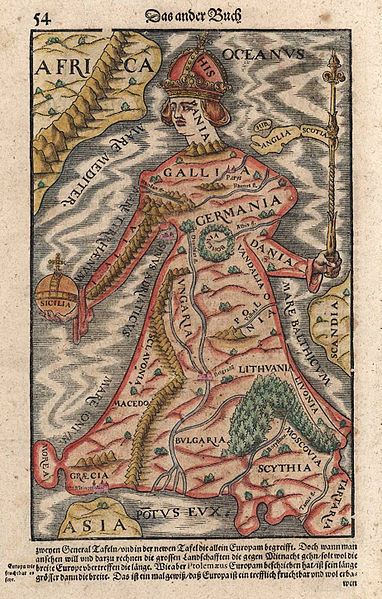Europa regina, Latin for Queen Europe, is the map-like depiction of the European continent as a queen. Made popular in the 16th century, the map shows Europe as a young and graceful woman wearing imperial regalia. The Iberian peninsula (Hispania) is the head, wearing a crown shaped like the Carolingian hoop crown. The Pyrenees, forming the neck, separate the Iberian peninsula from France (Gallia), which makes up the upper chest. The Holy Roman Empire is the centre of the torso, with Bohemia being the heart of the woman. Her long gown stretches to Hungary, Poland, Lithuania, Livonia, Bulgaria, Muscovy, Macedonia and Greece. In her arms, formed by Italy and Denmark, she holds a sceptre and an orb (Sicily). In most depictions, Africa, Asia and the Scandinavian peninsula are partially shown, as are the British Isles, in schematic form.
Europa regina in Sebastian Münster's "Cosmographia".
Sebastian Münster was a German cartographer and cosmographer. He also was a Christian Hebraist scholar who taught as a professor at the University of Basel. His well-known work, the highly accurate world map, Cosmographia, sold well and went through 24 editions. Its influence was widely spread by a production of woodcuts created of it by a variety of artists.
Portrait of Sebastian Münster by Christoph Amberger, c. 1552
Münster's Cosmographia
Tabula Novarum Insularum, 1540
Statue of Sebastian Münster in front of St. Remigius Church, Ingelheim





